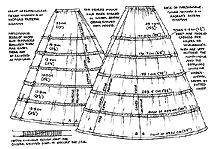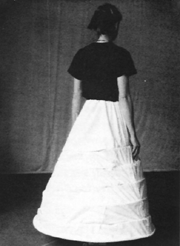
 Updated 7/7/2005
Updated 7/7/2005
Here, for all you fanatical costume buffs (like me) who would like to make a farthingale as close to Juan Alcega's 1589 pattern as possible, is a way to cut and make his pattern out of 45" wide fabric. Remember, though: the original pattern was for a woman 5 feet tall. The instructions below will give you a farthingale to fit your height, but the width of the farthingale may be a bit small for your taste (It measures only a yrd wide across the bottom) . In addition, the waist may be too small for you to gather it sufficiently to a waistband if you have wide hips.
If you want a wider waist measurement or a wider hoop, follow the instructions below using 60-inch wide fabric instead of 45-inch wide fabric. Cotton sheeting can be found in 60 inch wide lengths, as can some other fabrics. Ask at your local fabric store.
First, visit the Materials Page to find out what kind of materials you'll need.
Janet Arnold's analysis of Alcega's farthingale pattern explained the unusually long length by taking up 10 inches of the length by sewing tucks in the farthingale for the hoops. This method has been adopted by many who want to reproduce a period farthingale. I disagree with her analysis, as all of the kirtles, skirts and gowns in Alcega's pattern book have the same unusual length to them; it was not peculiar to farthingales. These instructions describe making a farthingale with sewn-on boning casings.
Take measurement A, multiply it by two, and buy that much fabric. For example: If my waist-to-ground measurement was 31 inches, I'd add 5 inches to that (36 inches) for measurement A, and multiply 36 by two (72 inches), and buy 72 inches(2 yards) of fabric.
What you'll end up with is 2 lengths of 22" wide fabric of the length you bought. Measurement sound familiar? Yep, Alcega's pattern was laid out on 22" wide silk.
Note: If your waist is larger than 40 inches around, your fabric lengths will need to be wider than 22" inches. To figure out how wide they will need to be, take your waist measurement, add 6 inches, and divide by two. Cut your fabric strips this wide, rather than 22" wide, and continue as directed below.
Out of one 22" wide piece, you're going to make the front and the back. Out of the other, you're going to make the triangular gores.
Front and Back:

You now have your front and back pieces. Now it's time to cut the gores.
 Side Gores:
Side Gores:
Lay the two pieces on top of eachother, and cut them according to the diagram to the right:
You're basically cutting a diagonal line from one corner of the rectangle to the other, creating two triangular pieces per piece of fabric you laid down. As noted on the diagram below, the B gore should be larger than the A gore, and should have a few inches width left at the top of the triangle. This will result in more fulness to the back sides than to the front, which is important if you want to reproduce the period sillouhette. The A gore, used for the front sides, should come to a point at the top.

Important: Sew the triangular gore to the front piece using the straight side (the edge which was against the edge of the fabric) and not the diagonal bias side which you cut out of the cloth. (See the Diagram to the left)
You should have an extra two inches of fabric left at the top sides, where the gores didn't reach to. Snip these off so that the triangular side lines run straight to the waist.
Now take the back center squarish piece of fabric, and sew the two B triangular gores to either side of it, starting at the waist and sewing towards the hem.
Important: Sew the B gores to the back piece by their bias side, not the straight side (see the diagram above)
Now sew the front and back together at the side seams, bottom to top.
You now have the skirt pieces themselves sewn together. The reason that attention is paid to whether the bias or the straight side of the gores is used is to ensure that two bias seams aren't sewn together at any place along the farthingale. As Alcega himself mentions, when two bias seams are sewn together, the skirt will stretch at that point and become longer--an important consideration with a garment such as a farthingale, which will be bearing the weight and strain of stiffening canes as well as the skirts over it. The preceding bias-straight pattern used in sewing the skirt together was taken straight from Alcega's instructions.
Check the hem of the farthingale to make sure that no pieces stick farther out; if they do, trim them so that the hem is an even circle all the way around.
First, draw out the lines of the boning hoops on the farthingale. Every few inches, measure up 6 inches from the bottom edge of the skirt, and mark this point with chalk or a fabric pencil. Connect the dots to create a line.
Now, measure up 5 inches from this line, and repeat the process. Measure up 5 more inches, and repeat again. Continue until you have five lines drawn.
To calculate how much material you will need for boning casings, measure each of these lines, plus the hem, and add 6 inches. This is the length of the fabric strip (or grosgrain ribbon/twill tape) necessary to make your boning casings. The fabric strip should be 2" wide to create a 1" casing, the standard width for 5/8" hoopskirt boning. If you use velvet or taffeta, back the strip with canvas for strength.
Starting at the center back of the bottom hem, lay the fabric strip with the right side of the strip against the wrong side of the farthingale. fold in the 2"wide edge of the strip in by half an inch at the beginning of the seam. Sew the two together half an inch from the edge. When you come back to the place you started, cut the strip, fold half an inch under, and sew it so that the beginning and end of the strip are butted together.
Turn the strip so that the right side lays against the outside of the farthingale. Iron the bottom edge. Fold the raw top edge of the strip in by 1/2 inch. Iron. Topstitch (or hand-stitch, if you want to be authentic) the top edge of the strip to the farthingale.
If top-stitching, you may find that the top of the strip puckers and gathers slighly, as the hoop narrows as it goes up. Take the time to pin the top strip down to even out and eliminate most of these gathers.
For the remaining hoops, the method is similar. Place the strip face-down against the right side of the farthingale below the first line drawn, with the edge of the strip against the line. Beginning at the center back, Sew the strip to the farthingale half an inch below the edge. Turn the strip up, iron, fold the top edge under, and stitch the top edge down.
Now, take the boning material. For each hoop, measure the length of that hoop and add a foot and a half. Cut this length of boning material and slip it into the hoop through the opening in the center back. Once the boning has made it all the way around, continue feeding the excess in until it is all inside the casing, with a foot and a half overlap at the back. This overlap prevents the farthingale from buckling at the opening. Stitch the opening shut, and repeat for the remaining casings.
Decide where you want the opening. Mark, and cut 8 inches down. Turn these edges in, iron, and stitch them down, reinforcing the point with extra stitches.
Now, mark where the waistband will be. Step into your farthingale, preferably with someone to assist you, and lift it to the proper height.
 The bottom edge should be three inches from the ground, and the back two inches from the ground. Adjust the farthingale so that the hem is at the proper height front and back, and mark where it reaches your waist. This will be the place where the waistband goes. Take the farthingale off, making sure the waistline is clearly marked all the way around. Trim the fabric of the farthingale at the waistline mark.
The bottom edge should be three inches from the ground, and the back two inches from the ground. Adjust the farthingale so that the hem is at the proper height front and back, and mark where it reaches your waist. This will be the place where the waistband goes. Take the farthingale off, making sure the waistline is clearly marked all the way around. Trim the fabric of the farthingale at the waistline mark.
Using a basting stitch (a wide stitch on your sewing machine, or a wide running stitch if you're doing this by hand), run a stitch half an inch from the top edge of the farthingale. Pull the thread at the end, and gather the fabric to the length of the waist. The gathers should be concentrated at the side and back of the corset. Lay a 1" wide strip of fabric right sides against the outside of the farthingale, with the edge of the strip against the top edge of the farthingale. Sew half an inch away from this edge, along the gathering line. Turn the strip around the raw edge of the farthingale to the inside, fold the excess over, and topstitch or handstitch the fabric down. They did not have wide waistbands in period; the waistband was simply to finish the top of a skirt.
Stitch a ribbon to each side of the opening, to tie the farthingale closed.
I like to make a small pad for the inside back of my farthingale, sewn into the back waistband. Although there is no evidence that this was done, It keeps the farthingale from tilting forward and helps to create the right silhouette when wearing it under Elizabethan gowns.